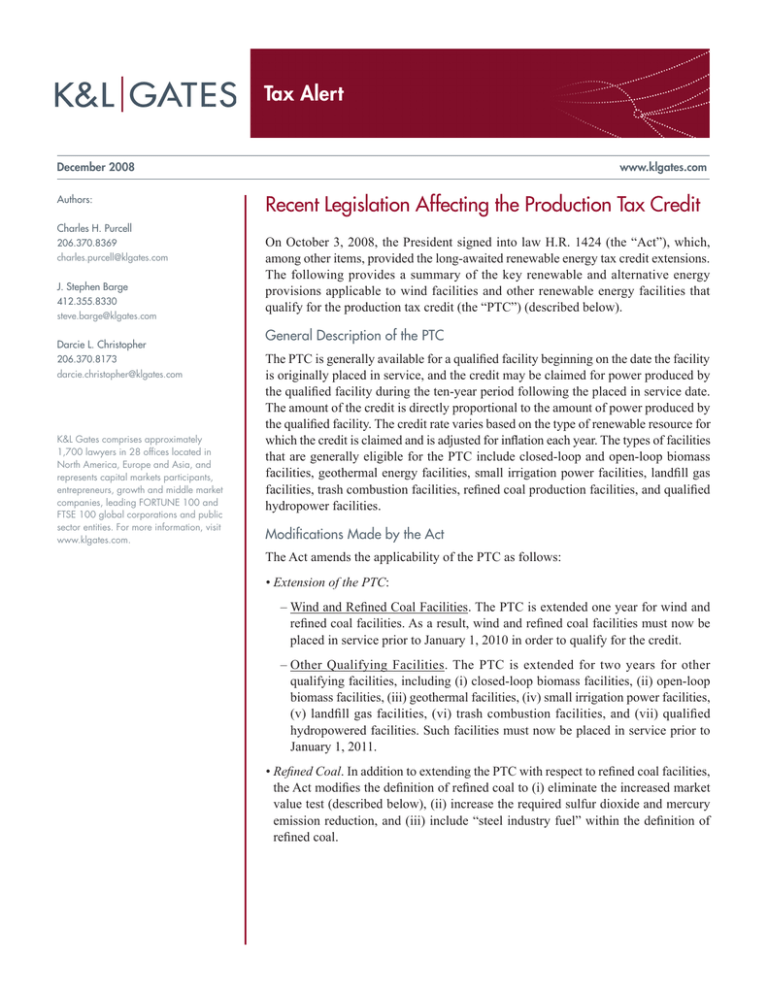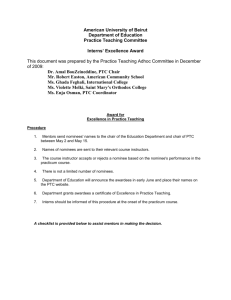
Tax Alert
December 2008
Authors:
Charles H. Purcell
206.370.8369
charles.purcell@klgates.com
J. Stephen Barge
412.355.8330
steve.barge@klgates.com
Darcie L. Christopher
206.370.8173
darcie.christopher@klgates.com
K&L Gates comprises approximately
1,700 lawyers in 28 offices located in
North America, Europe and Asia, and
represents capital markets participants,
entrepreneurs, growth and middle market
companies, leading FORTUNE 100 and
FTSE 100 global corporations and public
sector entities. For more information, visit
www.klgates.com.
www.klgates.com
Recent Legislation Affecting the Production Tax Credit
On October 3, 2008, the President signed into law H.R. 1424 (the “Act”), which,
among other items, provided the long-awaited renewable energy tax credit extensions.
The following provides a summary of the key renewable and alternative energy
provisions applicable to wind facilities and other renewable energy facilities that
qualify for the production tax credit (the “PTC”) (described below).
General Description of the PTC
The PTC is generally available for a qualified facility beginning on the date the facility
is originally placed in service, and the credit may be claimed for power produced by
the qualified facility during the ten-year period following the placed in service date.
The amount of the credit is directly proportional to the amount of power produced by
the qualified facility. The credit rate varies based on the type of renewable resource for
which the credit is claimed and is adjusted for inflation each year. The types of facilities
that are generally eligible for the PTC include closed-loop and open-loop biomass
facilities, geothermal energy facilities, small irrigation power facilities, landfill gas
facilities, trash combustion facilities, refined coal production facilities, and qualified
hydropower facilities.
Modifications Made by the Act
The Act amends the applicability of the PTC as follows:
• Extension of the PTC:
–W
ind and Refined Coal Facilities. The PTC is extended one year for wind and
refined coal facilities. As a result, wind and refined coal facilities must now be
placed in service prior to January 1, 2010 in order to qualify for the credit.
– Other Qualifying Facilities. The PTC is extended for two years for other
qualifying facilities, including (i) closed-loop biomass facilities, (ii) open-loop
biomass facilities, (iii) geothermal facilities, (iv) small irrigation power facilities,
(v) landfill gas facilities, (vi) trash combustion facilities, and (vii) qualified
hydropowered facilities. Such facilities must now be placed in service prior to
January 1, 2011.
• Refined Coal. In addition to extending the PTC with respect to refined coal facilities,
the Act modifies the definition of refined coal to (i) eliminate the increased market
value test (described below), (ii) increase the required sulfur dioxide and mercury
emission reduction, and (iii) include “steel industry fuel” within the definition of
refined coal.
Tax Alert
– The Act eliminates the requirement that refined
coal have an increased market value of at least
50%, as compared to the value of the feedstock
coal (the “increased market value test”). Thus,
in order to qualify for the PTC, refined coal is
now defined only under the first three conditions
that existed under prior law. Those include: (i)
type of fuel, (ii) sale by the taxpayer with the
reasonable expectation of producing steam, and
(iii) certification by the taxpayer that the refined
coal results in a qualified emission reduction.
This provision applies for coal produced and
sold from facilities placed in service after
December 31, 2008.
– The Act adds a quantitative percentage test to
the required reduction of the release of sulfur
dioxide or mercury that doubles (from 20%
to 40%) the reduction required prior to the
Act. This provision applies to coal produced
and sold from facilities placed in service after
December 31, 2008.
– The Act modifies the definition of refined coal
to include “steel industry fuel” so that the PTC
applies to steel industry fuel. Thus, it is possible
that a taxpayer may qualify for both the PTC and
the non-conventional fuel credit under Section
45K of the Code. Because the taxpayer may
only claim one of the credits, such taxpayer will
have to determine which credit will provide the
taxpayer with the maximum tax savings. This
provision applies for fuel produced and sold
after September 30, 2008.
• Extension of PTC to Marine and Hydrokinetic
Renewable Energy. The Act extends the PTC to
marine and hydrokinetic renewable energy.
– For this purpose “Marine and Hydrokinetic
Renewable Energy” includes energy derived
from (i) waves, tides, and currents in oceans,
estuaries and tidal areas, (ii) free flowing water
in rivers, lakes, and streams, (iii) free flowing
water in an irrigations system, canal, or other
man-made channel, including projects that
utilize non-mechanical structures to accelerate
the flow of water for electric power production
purposes, or (iv) differentials in ocean
temperature. This does not include any source
that utilizes a dam, diversionary structure, or
impoundment for electric power production
purposes.
– Facilities producing marine and hydrokinetic
renewable energy must (i) have a nameplate
capacity rating of at least 150 kilowatts and (ii)
be placed in service before January 1, 2012.
– The amount of the PTC with respect to such
facilities is half of the amount available for
wind and closed-loop facilities.
• M odification of Rules for Hydropower
Production. The Act replaces the definition of
“nonhyrdroelectric dam” with a new definition
that requires the hydroelectric project be operated
so that the water surface elevation at any given
location and time that would have occurred in the
absence of the hydroelectric project is maintained.
This provision applies to property originally placed
in service after December 31, 2008.
• Trash Combustion Facility Definition Modified.
The definition of “trash combustion facility” is
expanded to provide that such facilities must “use”
municipal solid waste. Previously, such facilities
were required to “burn” municipal solid waste.
This provision applies to electricity produced and
sold after October 3, 2008.
• Expansion of Open- or Closed-Loop Biomass
Facilities. The expansion of an open-loop or
closed-loop biomass facility that qualified for
the PTC will also qualify for the PTC if such
expansion is placed in service on or after October
3, 2008 and before January 1, 2011. This credit is
available to the extent of the increase in the amount
of electricity produced at the facility as a result of
the new unit. This provision applies to expansions
placed in service after October 3, 2008.
December 2008 | 2
Tax Alert
For more information regarding the modifications
made by the Act or the PTC in general, please contact
Charles H. Purcell. In addition, please see our summary
“Recent Legislation Affecting the Energy Tax Credit”
for a summary of energy provisions included in the
Act that address other types of renewable energy, such
as solar power, and our summary “Recent Legislation
Affecting the Residential Energy Efficient Property
Credit” for a summary of the energy provisions in the
Act that directly affect individuals.
K&L Gates comprises multiple affiliated partnerships: a limited liability partnership with the full name K&L Gates LLP qualified in Delaware and
maintaining offices throughout the U.S., in Berlin, in Beijing (K&L Gates LLP Beijing Representative Office), and in Shanghai (K&L Gates LLP
Shanghai Representative Office); a limited liability partnership (also named K&L Gates LLP) incorporated in England and maintaining our
London and Paris offices; a Taiwan general partnership (K&L Gates) which practices from our Taipei office; and a Hong Kong general
partnership (K&L Gates, Solicitors) which practices from our Hong Kong office. K&L Gates maintains appropriate registrations in the
jurisdictions in which its offices are located. A list of the partners in each entity is available for inspection at any K&L Gates office.
This publication is for informational purposes and does not contain or convey legal advice. The information herein should not be used or
relied upon in regard to any particular facts or circumstances without first consulting a lawyer.
©1996-2008 K&L Gates LLP. All Rights Reserved.
December 2008 | 3





